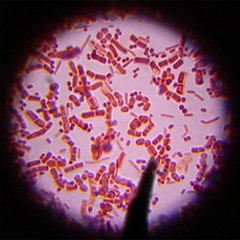Miller LITE 17th ed chapter 3 vocabulary on ecosystems: what are they and how do they work
| 8655851578 | troposphere | extends only about 17 km or 11 mi above sea level at the tropics and about 7 km or 4 mi about the earth's north and south poles. Contains the air we breathe (78% N, 21% O, 1%: water vapor, CO2, and CH4). |  | 0 |
| 8655851579 | greenhouse gases | water vapor, CO2, CH4, etc. that absorb and release energy that warms the lower atmosphere. |  | 1 |
| 8655851580 | stratosphere | stretches 17-50 km or 11-31 mi above earth's surface and holds ozone (O3) to filter out harmful UV radiation from the sun. |  | 2 |
| 8655851581 | hydrosphere | consists of all the water on or near the earth's surface. Found as water vapor, liquid water, ice (polar ice, icebergs, glaciers, and permafrost). |  | 3 |
| 8655851582 | biosphere | consists of the parts of the atmosphere, hydrosphere, and geosphere where life is found. |  | 4 |
| 8655851588 | biotic factors | living components of an ecosystem. Ex.: black bear |  | 5 |
| 8655851589 | abiotic factors | nonliving components of an ecosystem. Ex.: water |  | 6 |
| 8655851590 | trophic level | a feeding level that depends on its source of food or nutrients. |  | 7 |
| 8655851593 | phytoplankton | the mostly microscopic dominant producers that float or drift in water. |  | 8 |
| 8655851596 | zooplankton | the mostly microscopic primary consumers that feed on phytoplankton in water ecosystems. |  | 9 |
| 8655851597 | carnivores | are animals that feed on the flesh of other animals. Ex.: lions |  | 10 |
| 8655851600 | omnivores | those that eat both plants and other animals. Ex.: humans, pigs, rats. |  | 11 |
| 8655851601 | detritus feeders or detritivores | feed on the wastes or dead bodies of other organisms. Ex.: earthworms, some insects, vultures |  | 12 |
| 8655851603 | aerobic respiration | a process that uses oxygen to convert glucose or other organic nutrients back into carbon dioxide and water. |  | 13 |
| 8655851604 | microbes or microorganisms | thousands of species of bacteria, protozoa, fungi, and floating phytoplankton are lumped under this name due to their size. |  | 14 |
| 8655851607 | biomass | the dry weight of all organic matter contained it its organisms. | 15 | |
| 8655851608 | biomass pyramid | shows the decrease in dry weight of all organic matter in organisms at each succeeding trophic level in a food chain or web. | 16 | |
| 8655851609 | Net primary productivity (NPP) | the rate at which producers use photosynthesis to produce and store chemical energy minus the rate at which they use some of this stored energy through cellular respiration. | 17 | |
| 8655851610 | Gross primary productivity (GPP) | the rate at which an ecosystems's producers convert solar energy into chemical energy in the form of biomass found in their tissues. Ex.: kcal/m2/yr | 18 | |
| 8655851611 | biogeochemical cycles or nutrient cycles | how elements and compounds that make up nutrients move continually through air, water, soil, rock, and living organisms within ecosystems. | 19 | |
| 8655851612 | hydrologic or water cycle | this collects, purifies, and distributes the earth's fixed supply of water. It includes evaporation, precipitation, and transpiration. |  | 20 |
| 8655851613 | evaporation | the part of the water cycle where water leaves the earth's oceans, rivers, lakes, and soil into the atmosphere. |  | 21 |
| 8655851614 | Precipitation | the part of the water cycle where water leaves the atmosphere as a liquid back to the earth as rain, snow, sleet, and dew. |  | 22 |
| 8655851615 | transpiration | this is the evaporation of water from the surfaces of plants and soil back into the atmosphere. |  | 23 |
| 8655851616 | glacier | a large persistent body of ice that forms over many years of melting and sublimation of snow. | 24 | |
| 8655851617 | surface run-off | water from precipitation that is carried back to lakes and oceans by gravity to complete the water cycle. | 25 | |
| 8655851618 | aquifer | underground layers of rock, sand, and gravel where water is stored. | 26 | |
| 8655851619 | groundwater | the water found in aquifers. | 27 | |
| 8655851620 | carbon cycle | how carbon circulates through the biosphere. It is based on CO2 gas and involves photosynthesis, respiration, fossil fuels, etc. |  | 28 |
| 8655870778 | percolation | he process of a liquid slowly passing through a filter | 29 |

